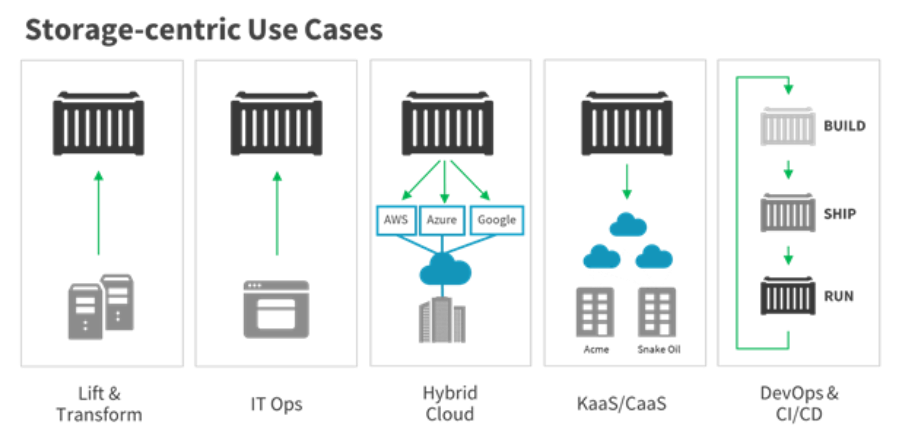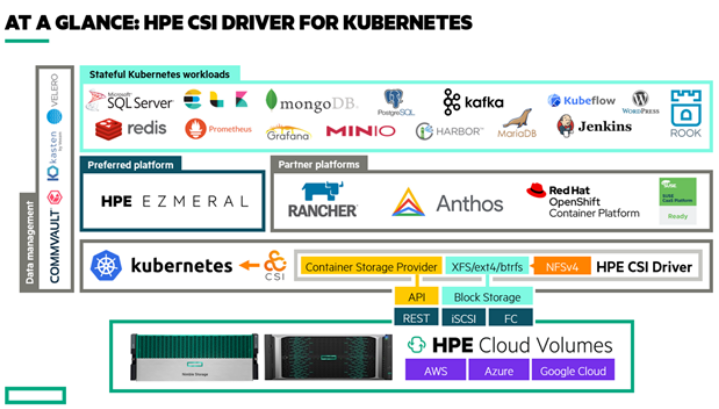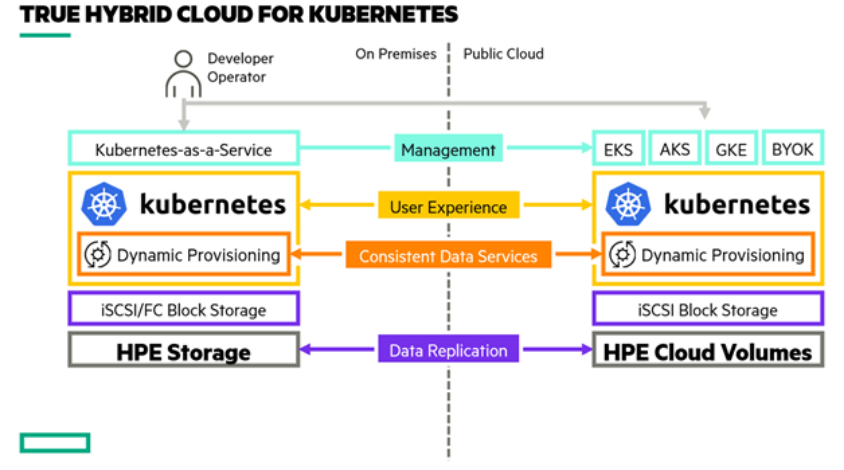ESG WHITE PAPER
Simplify Kubernetes Environments with the HPE CSI Driver
A Better Way to Manage Hybrid Storage Resources and Support DevOps Initiatives
By Scott Sinclair, ESG Senior Analyst and Monya Keane, ESG Senior Research Analyst
JANUARY 2021
Introduction
Container adoption has had a very clear effect on modern business. An ESG research study of IT professionals whose organizations are using containers or planning to use them to support production applications in the next 12 months found that 53% of the respondents said improving modern DevOps practices was their catalyst for container adoption. These respondents identified several benefits of leveraging container technology—the three most commonly reported benefits related to:
Achieving better application performance (cited by 50%).
Improved software quality (45%).
Better application portability (45%).1
The value that container-based environments provide to application development initiatives has fueled increased adoption for the technology. In a separate ESG research survey conducted in 2019, 41% of storage decision makers indicated that their organizations were using containers in production. An additional 33% reported that they were using containers to support dev/test and pre-production applications and planned to use them for production within the following 12 months.2
As organizations scale their production Kubernetes environments, however, they often discover a hard truth. The optimal infrastructure environment for Kubernetes container-based workloads has different and more extensive requirements than what traditional applications typically need. Simply staying with the status quo is often not the right answer. Understanding these differences—and leveraging technologies and partners that can address the needs of container-based environments—is essential for any organization seeking to maximize the benefits of container-based, or Kubernetes, environments.
HPE, a leader in IT infrastructure, offers a powerful, versatile platform that not only supports the needs of enterprise container workloads, but also does so in a manner that allows development teams to maximize the value of containers and Kubernetes to the whole company. Playing a key role in delivering these benefits, HPE’s Container Storage Interface (CSI) technology simplifies and optimizes container integration for persistent storage across modern, hybrid, and multi-cloud infrastructure environments.
Optimizing IT to Meet the Needs of a Kubernetes-based Environment
For container-based applications, leveraging a distributed infrastructure (i.e., a hybrid or multi-cloud infrastructure) has become the norm. Seventy percent of organizations leveraging containers reported to ESG that their container-based applications are (or would be) deployed in a combination of public clouds and private data centers.3
Figure 1 sheds light on the drivers behind the hybrid cloud approach to using containers. The biggest areas of appeal center on improving performance (51%), improving user productivity (44%), improving time to application deployment (38%), and several benefits tied to application development as well.4
Figure 1. Drivers Behind the Hybrid-cloud Approach for Deploying Container-based Environments
Why is it important for your organization to be able to run some applications (or microservices) on public cloud infrastructure services versus running all applications onpremises? (Percent of respondents, N=225, multiple responses accepted)
Source: Enterprise Strategy Group
Increased IT Complexity and Storage Challenges Can Accompany Container-based Environments
Infrastructure-related challenges with enterprise-scale container environments may result in more IT complexity overall. Three quarters (75%) of IT professionals surveyed by ESG said they believe IT is more complex compared with two years ago. Among those who identify IT as being more complex, almost a third (28%) cite increases in applications that leverage modern architectures, such as Kubernetes, as a top reason behind the complexity increase.5
ESG also found that 36% of IT leaders inside organizations that are leveraging or planning to leverage container-based application environments believe that managing these applications in a hybrid environment is one of their top container-specific challenges. The essential role that storage plays in a container environment is reflected in the challenges these organizations face. Some of the most significant persistent-storage-specific challenges relate to managing effectively across a hybrid, multi-cloud environment; speeding up provisioning; and supporting application portability (see Figure 2).6
Figure 2. Top Challenges with Persistent Storage for Container-based Environments
In general, what would you say are your organization’s biggest persistent storage-related challenges in terms of its container-based environment? (Percent of respondents, N=274, multiple responses accepted)
Source: Enterprise Strategy Group
Designing a Distributed Infrastructure Environment Optimized for Container-based Applications
The central goal of a container environment is to help the business accelerate its application development projects. But what does that mean? It means being able to stand up suitable storage resources quickly, on demand, wherever they need to be located, while ensuring a consistent user experience. Often, Kubernetes clusters are stood up, destroyed, and then recreated quickly. The concept behind containers is that they should be ephemeral in this way—i.e., spun up, and then destroyed as necessary. Allocating persistent storage does not change this core container characteristic. The environment needs to be able to deliver and protect persistent storage while not interfering with containers’ fleeting, transient nature. That means that—in addition to ensuring performance and availability, plus consistency across hybrid cloud environments—separating the data storage layer from the cluster is going to be beneficial.
- What should an IT architect look for when designing an environment meant to optimize containers? ESG recommends taking the following factors into consideration: Supporting Kubernetes environments with persistent storage is just the beginning. The Container Storage Interface (CSI) may be a standard, but not all vendors’ CSI options are created equal.
- The persistent storage supporting the container must be highly performant and highly available. Performance is twice as likely to be a challenge with container-based workloads (36%) than with traditional SAN-based workloads (17%).7

- Ensuring consistency of management and a consistent user experience across the distributed hybrid/multi-cloud environments is going to be crucial.
- If the goal is to accelerate application development work, IT architects will need to create an infrastructure that is flexible enough to support the ephemeral nature of container environments, perhaps by separating the data storage and data protection from the Kubernetes cluster. In this way, they will ensure data persistence and protection as clusters are stood up, scaled, and replaced.
HPE CSI Driver for Kubernetes
As mentioned, not all CSI variants are indistinguishable. HPE’s CSI driver for Kubernetes possesses some distinctive characteristics:
- It works with the HPE primary storage portfolio, offering support for iSCSI, FC, and REST API access for management.
- It spans both data center and public cloud deployments of HPE primary storage technology, and it supports HPE Cloud Volumes, a suite of enterprise cloud data services.
- It offers users the ability to dynamically provision persistent volumes (as dictated by the template established by the organization’s cluster and storage administrators).

- It allows users to expand volumes, clone volumes, or take snapshots of data for reuse as prescribed by Kubernetes administrators.
In turn, those special characteristics of HPE’s CSI driver provide multiple real-world benefits:
- Excellent performance and availability— The driver connects with HPE’s portfolio of enterprise storage technologies including its all-flash solutions, NVMe-based HPE Primera, and HPE Nimble storage. When combined with HPE’s Peer Persistence technology, it can help organizations create a continuous data availability environment across multiple sites and multiple HPE storage arrays to deliver high availability even in the event of site-wide or natural disasters
- Consistent experience across a distributed hybrid cloud environment— The single HPE CSI driver supports HPE’s storage technologies running in both the data center and in the cloud (with HPE Cloud Volumes). This means developers can enjoy the flexibility of working with a single piece of technology, knowing that their code will work properly across all locations.
- Accelerated application development— When storage is kept separate from the Kubernetes cluster, existing clusters can be taken down and redeployed without impacting the data. The data stays protected and can be made available again as soon as a new cluster is provisioned. In other words, the development environment can be deployed and recovered quickly, without too much concern over the safety of the data.
In addition to application development projects, HPE’s CSI driver accelerates organizations’ digital initiatives, too, providing:
- Application and infrastructure modernization via lift and shift— Thanks to HPE’s support for VMware vSphere Virtual Volumes (vVOLs), an admin can move a virtual disk over to the preferred storage environment using VMware vMotion and then test the cutover with a clone. Once everything is confirmed, the admin can delete the virtual machine and virtual disk and then import the data into a container volume from the standalone volume.
- Application mobility and data replication across a hybrid cloud environment— HPE’s consistent CSI interface works across both the data center and the public cloud, which means that HPE replication technology can ensure that the data remains consistent throughout, while Kubernetes ensures a consistent experience, consistent management, and consistent data services. Essentially, apps are free to move across the environments.

- Storage multi-tenancy for Kubernetes environments— HPE offers the ability to control performance on a per-volume basis with quality-of-service (QoS) controls to ensure that application experience stays consistent as the container environment scales and evolves over time. Within a managed service provider’s site, multi-tenancy is a critical factor to address. HPE reports that it already has MSP customers leveraging its CSI driver for their Kubernetes application deployments.
- Accelerated deployment of development environments— With HPE’s cloning technology integrated with its CSI technology, cluster admins can quickly and easily set up new developer environments and workspaces, adding efficiency both from a storage reduction perspective and time to value.
- Support for IT transformation initiatives—HPE simplifies the integration and management of container-based and traditional application environments, allowing IT organizations to accelerate IT transformation initiatives, offering more control to developers and allowing IT personnel more time to focus on higher business-level goals.
The Bigger Truth
Containers are designed for portability, so any organization using them must create an architecture that allows for data to be wherever it needs to be, whenever it needs to be there, often in a hybrid, multi-cloud environment.
Unfortunately, a lot of other storage vendors’ messaging in regard to infrastructure for Kubernetes seems mostly as if they are simply trying to “check the box”—they just want to claim that their storage supports containers. HPE is different. It has a real storyline, one based on a sincere attempt to understand why organizations are deploying containers.
Organizations deploy containers because it makes DevOps better, and it makes managing a combination of traditional apps and modern apps much easier. In turn, that advantage then helps to fuel all sorts of beneficial digital initiatives, leading to full-scale digital transformation. It is commendable that HPE has put so much effort into studying what its customers are trying to use containers to do and then tailoring each feature and container integration of the HPE CSI Driver directly to those customers’ real-life wants and needs.
Tutorial: How to get started with the HPE CSI Driver and HPE Primera and 3PAR
1 Source: ESG Master Survey Results, Trends in Modern Application Environments, Dec 2019.
2 Source: ESG Master Survey Results, 2019 Data Storage Trends, Nov 2019.
3 Source: ESG Master Survey Results, Trends in Modern Application Environments, Dec 2019.
4 ibid.
5 Source: ESG Master Survey Results, 2021 Technology Spending Intentions Survey, Dec 2020.
6 Source: ESG Master Survey Results, 2019 Data Storage Trends, Nov 2019.
7 Source: ESG Master Survey Results, 2019 Data Storage Trends, Nov 2019.
This ESG White Paper was commissioned by HPE and is distributed under license from ESG.
All trademark names are property of their respective companies. Information contained in this publication has been obtained by sources The Enterprise Strategy Group (ESG) considers to be reliable but is not warranted by ESG. This publication may contain opinions of ESG, which are subject to change from time to time. This publication is copyrighted by The Enterprise Strategy Group, Inc. Any reproduction or redistribution of this publication, in whole or in part, whether in hard-copy format, electronically, or otherwise to persons not authorized to receive it, without the express consent of The Enterprise Strategy Group, Inc., is in violation of U.S. copyright law and will be subject to an action for civil damages and, if applicable, criminal prosecution. Should you have any questions, please contact ESG Client Relations at 508.482.0188.

Enterprise Strategy Group | Getting to the Bigger Truth™
Enterprise Strategy Group is an IT analyst, research, validation, and strategy firm that provides market intelligence and actionable insight to the global IT community.

